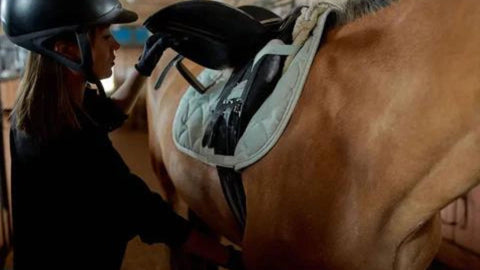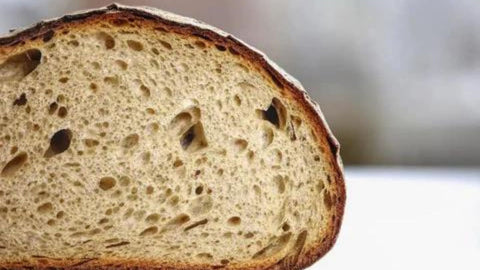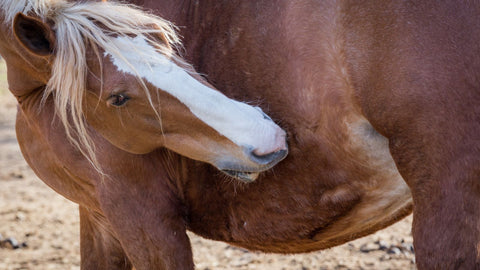
Florian ist aufgewachsen auf einem Bauernhof. Umgeben von Pferden, entdeckte er früh seine Faszination für diese majestätischen Tiere. Inspiriert von seiner reitbegeisterten Mutter, entwickelte er das Nahrungsergänzungmittel - Pferdegold. Seine tiefe Verbundenheit zur Natur und die leidenschaftliche Hingabe zu Pferden trieben ihn an, sein Unternehmen zu gründen.
Girth pressure (also saddle pressure) in horses is a not uncommon and serious phenomenon that causes a lot of stress for both the horse and the rider.
This is a defensive reaction of the horse when being saddled or the girth is being fastened. Unfortunately, this reaction is often triggered by pain.
In this article, we will examine in detail the causes of seat belt pressure and present various measures to solve this problem.
The goal is that saddling no longer represents a stressful situation for the four-legged friend.
Ultimately, we want saddling to be a pain-free and positive experience for the horse.

What is girth pressure in horses?
Girth pressure refers to a situation in which the horse shows resistance to the girth being applied . This can manifest itself in various behaviors, such as threatening by pinning its ears , biting , kicking , or snapping .
It is a clear stress reaction of the horse, which can indicate pain, discomfort or even fear.
Causes of girth pressure in horses
Girth pressure in horses can have various causes. While some horses react due to pain or discomfort, for others an ill-fitting saddle may be the trigger.
In the following, we will look at the most common causes of seat belt restraint.

One of the most common causes: stomach ulcers
It's like a curse: Imagine your horse suddenly refuses to be saddled or girthed. It snaps , kicks , and pins its ears back. On top of that, its nostrils are raised.
All these are clear signs of discomfort .
But what is going on?
Could it be seat belt restraint? If this behavior is repeated, it could indeed be the case. But what are the reasons for it?
Research from the USA has shown that gastric ulcers are a common cause of girth pressure in horses.
In a study of 37 horses that showed girth pressure, twelve of them suffered from gastric ulcers .
Interestingly, in almost all of the horses examined (35 of 37), pain was the trigger for defensive behavior when girthed.
Of these , ⅓ were affected by stomach ulcers .
A horse with stomach ulcers often has severe abdominal pain , which can be aggravated by the pressure of the girth .
So it is understandable that the horse will do everything to avoid the girth.
And this bad mood can quickly become dangerous for the rider . Some horses immediately start biting or hitting when they see the girth or saddle.
But there are also animals that are completely cool when they see the saddle and even when they put it on, and only go completely crazy when you grab it under their belly.
Inappropriate saddle
An ill-fitting saddle can also lead to girth pressure. A saddle that doesn't fit properly can cause pressure sores and pain , causing the horse to resist the girth being applied.
It is therefore important that the saddle is fitted correctly and does not cause any discomfort .
A well-fitting saddle is essential for your horse's health. It can help prevent or alleviate girth pressure .
It is therefore advisable to have the saddle checked regularly by a specialist and adjusted if necessary.
Incorrect approach to the saddle during the break-in phase can also trigger girth pressure in the horse.
This can be caused, for example, by confronting the saddle too quickly or carelessly.

Pferdegold® supplementary feed!
Pferdegold is a small family business from Bavaria with a big dream: to produce the best horse feed. We see ourselves as a family of equestrians who want to provide your horse with the ideal nutrition. 100% natural and perfectly tailored to your horse's needs.
Try it now!How does girth pressure manifest itself in horses?
Girth pressure in horses can manifest itself in various ways. It's important to recognize the signs so you can identify the problem early and take appropriate action. This is the only way to improve the situation for your horse.
Seat belt compulsion: the symptoms
-
Ears pinned back: The horse pins its ears back, which can be a sign of discomfort or anger .
-
Snapping and biting: Your horse may snap or bite when you put on the girth.
-
Nostrils raised: Nostrils raised can be a sign of stress or anxiety .
-
Rapid breathing or holding the breath: Rapid breathing or holding the breath can also indicate stress or anxiety in your horse.
-
Head banging: Some horses bang their heads when they feel uncomfortable.
-
Turning the head back towards the saddle: Turning the head is an early sign of pain and may be the horse's attempt to get rid of the saddle or girth .
-
Threatening with the hind leg or kicking forward: A horse that threatens or kicks forward with its hind leg clearly shows that it is uncomfortable. It may be expressing its reluctance to have the girth applied .
-
Snapping at the air or the rope: This can be a sign of frustration or fear.
-
Licking metal, nibbling wood: Licking metal compensates for a mineral deficiency. Nibbling wood can indicate boredom. When horses bite into it, it's usually a sign of frustration release .
-
Tense gait: If a horse gait is tense, this can be a sign that it is uncomfortable or in pain .
- Throwing down: A horse that throws itself down shows an extreme form of defensive behavior.
Resolving saddle pressure in horses
There are several ways to alleviate or completely eliminate your horse's girth pressure. The solution depends on the specific cause of the problem.
In some cases, medical treatment may be necessary; in other cases, adjusting the saddle or girth, or simply gentle training, may help.
It is important that you interpret your horse's signals correctly and respond to its needs.
Treat health problems
If gastric ulcers are diagnosed, the horse will usually receive medication from the veterinarian, most often acid reducers such as omeprazole.
These so-called proton pump inhibitors keep stomach acid in check , allowing stomach ulcers to heal more effectively.
Most horses receive omeprazole for four weeks .
You can also support your horse's gastrointestinal tract with a high-quality supplement. The ingredients, such as Omega 3 , are particularly important.
The polyunsaturated fatty acids are considered anti-inflammatory .
Check saddle girth
An important step in resolving saddle pressure is checking the girth. It should n't be too tight , as this can lead to discomfort and pain. Make sure the girth is correctly positioned and doesn't slip.
A good girth should also be well padded to avoid pressure points.
Check and adjust saddle
An ill-fitting saddle can also lead to saddle pressure . It's important that the saddle sits properly on the horse's back and doesn't pinch or chafe.
If you're unsure whether the saddle fits properly, you should consult a saddler. They can adjust the saddle or help you choose a new one.
Have your veterinarian rule out pain
If your horse repeatedly shows signs of saddle pressure, you should consult a veterinarian .
This can rule out other causes for the behavior, such as pain caused by injury or illness .
A thorough examination can help to find the exact cause of saddle pressure and initiate appropriate measures.
Slowly get your horse used to being saddled
If saddling is new to your horse, it's important to introduce him to the process slowly and gently . Start with short sessions and gradually increase the duration.
Always pay attention to your horse's reactions . If it shows signs of stress or discomfort, take a break and try again later.
Gently fasten the seat belt
You should also proceed carefully when girthing. Don't pull the girth on too quickly or too tightly. Give your horse time to get used to the feel of the girth.
Some horses are particularly sensitive to being girthed, so it is important to always be patient and sensitive.
Final thoughts
Belt tension is a complex challenge that requires both patience and understanding. With the right approach and support from experts, such as a veterinarian, this problem can be solved.
Remember that every horse is unique and needs its own time to adjust to changes.
With love, patience and the right tools, even horses with girth sensitivity can enjoy riding again.
Ultimately, your horse's well-being is the most important thing and the key to many happy hours in the saddle.
FAQ
Which saddle girth is recommended for girth constraints?
If girth pressure is present, a well-padded and anatomically shaped girth can be helpful. It shouldn't be too tight and should be able to follow the horse's movements. A saddler can help you find the right girth for your horse.
How can I help my horse with girth pressure?
When it comes to girth pressure, it's important to identify and treat the cause. This may involve medical treatment, adjusting the saddle or girth, or gentle training. A veterinarian or experienced trainer is the right person to contact for this issue.
IMPORTANT:
Pferdegold is not a substitute for veterinary diagnosis or treatment. The information contained in this article is for general informational purposes only and is intended to help improve your horse's well-being. Pferdegold products do not treat or cure illnesses, but rather support your horse in correcting nutritional deficiencies through targeted nutrient intake.
However, they are not a substitute for professional advice from a veterinarian or specialist. If your horse has any health problems, we strongly recommend consulting a veterinarian. Pferdegold assumes no liability for decisions made based on the information provided here.

















